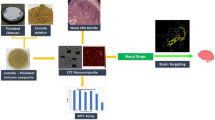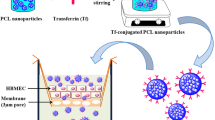ABSTRACT
Purpose
In order to develop non-invasive and effective nose-to-brain delivery of drugs, we synthesized Tat analog-modified methoxy poly(ethylene glycol) (MPEG)/poly(ε-caprolactone) (PCL) amphiphilic block copolymers through the ester bond.
Methods
We evaluated the brain distribution of coumarin, acting as a model chemical, after intravenous or intranasal administration of MPEG-PCL. In addition, cellular uptake of coumarin by rat glioma cells transfected with coumarin-loaded MPEG-PCL or MPEG-PCL-Tat was determined. Finally, we determined the brain distribution and biodistribution after intranasal administration of coumarin-loaded MPEG-PCL-Tat.
Results
The amount of coumarin in the brain after intranasal administration was significantly higher than that after intravenous administration. In addition, cellular uptake of coumarin using MPEG-PCL was the lowest, while cellular uptake of coumarin using Tat-modified MPEG-PCL (MPEG-PCL-Tat) was higher than that of MPEG-PCL. Therefore, the brain distribution of coumarin administered using MPEG-PCL-Tat was significantly greater than that using MPEG-PCL. Then, the coumarin distribution after MPEG-PCL-Tat administration in non-targeted tissues (lung, liver, heart, kidney and spleen) was lower than that after coumarin administration without nanomicelles.
Conclusion
We have demonstrated that utilization of nano-sized micelles modified with Tat can facilitate direct intranasal brain delivery.






Similar content being viewed by others
REFERENCES
CBTRUS, Central Brain Tumor Registry of the United States. Primary Brain Tumors in the United Atates: Statistical Report Tables, 1998–2002. 2005. Available from: http://www.cbtrus.org/2005-2006/tables/2006.table18-19.pdf.
Hashizume R, Ozawa T, Gryaznov SM, Bollen AW, Lamborn KR, Frey 2nd WH, et al. New therapeutic approach for brain tumors: intranasal delivery of telomerase inhibitor GRN163. Neuro Oncol. 2008;10:112–20.
Illum L. Transport of drugs from the nasal cavity to central nervous system. Eur J Pharm. 2000;11:1–18.
Illum L. Is nose-to-brain transport of drugs in man a reality? J Pharm Pharmacol. 2004;56:3–17.
Mistry A, Stolnik S, Illum L. Nanoparticles for direct nose-to-brain delivery of drugs. Int J Pharm. 2009;379:146–57.
Dhanda DS, Frey 2nd WH, Leopold D, Kompella UB. Approaches for drug deposition in the human olfactory epithelium. Drug Deliv Technol. 2005;5:64–72.
Thorne RG, Pronk GJ, Padmanabhan V, Frey 2nd WH. Delivery of insulin-like growth factor-1 to the rat brain and spinal cord along olfactory and trigeminal pathways following intranasal administration. Neuroscience. 2004;127:481–96.
Thorne RG, Frey 2nd WH. Delivery of neurotrophic factors to the central nervous system: pharmacokinetic considerations. Clin Pharmacokint. 2001;40:907–46.
Dhuria SV, Hanson LR, Frey 2nd WH. Intranasal delivery to the central nervous system: mechanism and experimental considerations. J Pharm Sci. 2010;99:1654–73.
Yang S, Coles DJ, Esposito A, Mitchell DJ, Toth I, Minchin RF. Cellular uptake of self-assembled cationic peptide-DNA complex: multifunctional role of the enhancer chloroquine. J Control Release. 2009;135:159–65.
Rajagopalan R, Xavier J, Rangaraj N, Rao NM, Gopal V. Recombinat fusion proteins TAT-Mu. Mu and Mu-Mu mediate efficient non viral gene delivery. J Gene Med. 2007;9:275–86.
Tanaka K, Kanazawa T, Shibata Y, Suda Y, Fukuda T, Takashima Y, et al. Development of cell-penetrating peptide-modified MPEG-PCL diblock copolymeric nanoparticles for systemic gene delivery. Int J Pharm. 2010;396:229–38.
Kanazawa T, Takashima Y, Hirayama S, Okada H. Effects on menstrual cycle on gene transfection through mouse vagina for DNA vaccine. Int J Pharm. 2008;360:164–70.
Uchida T, Kanazawa T, Takashima Y, Okada H. Development of an efficient transdermal delivery system of small interfering RNA using functional peptides, Tat and AT1002. Chem Pharm Bull. 2011;59:196–201.
Yokoyama M, Opanasopit P, Okano T, Kawano K, Maitani Y. Polymer design and incorporation methods for polymeric micelle carrier system containing water-insoluble anti-cancer agent camptothecin. 2004;12:373–84.
Brooking J, Davis SS, Illum L. Transport of nanoparticles across the rat nasal mucosa. J Drug Target. 2001;9:267–79.
ACKNOWLEDGMENTS
We thank Mr. Shohei Suzuki and Mr. Fuminari Akiyama (School of Pharmacy, Tokyo University of Pharmacy and Life Sciences) for their excellent technical assistance. We are also grateful to Prof. Tsunehiko Fukuda, Ph.D. (Nagahama Institute of Bio-Science and Technology) for the peptide synthesis. This study was supported in part by a grant for private universities provided by the Promotion and Mutual Aid Corporation for Private Schools of Japan.
Author information
Authors and Affiliations
Corresponding author
Additional information
Takanori Kanazawa and Hiroyuki Taki contributed equally to this work.
Rights and permissions
About this article
Cite this article
Kanazawa, T., Taki, H., Tanaka, K. et al. Cell-Penetrating Peptide-Modified Block Copolymer Micelles Promote Direct Brain Delivery via Intranasal Administration. Pharm Res 28, 2130–2139 (2011). https://doi.org/10.1007/s11095-011-0440-7
Received:
Accepted:
Published:
Issue Date:
DOI: https://doi.org/10.1007/s11095-011-0440-7




